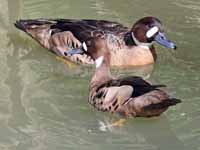The term waterfowl is used to describe any member of the order Anseriformes. A series of articles describes all the waterfowl. This specific article describes the "dabbling ducks" which belong to family Anatidae, subfamily Anatinae.
Anseriformes
Most species of the order Anseriformes spend a considerable amount of time in water. In fact, they are called waterfowls. Their webbed feet make for efficient swimming. A few species spend little time in water and thus their feet are only partially webbed. Most waterfowl are also good flyers, many migrating long distances to escape the cold and others migrating shorter distances for optimizing their food supply. All species, except the screamers, have a wide and relatively flat bill. The shape of a species bill and also their tongue is a function of their diet. Considering the entire order, they eat aquatic plants, grasses, sedges, algae, plankton, insects, insect larvae, mollusks, crustaceans, fish, fruits, grains, rice. Most species are monogamous and if they lose a partner seem to mourn. Males are larger and heavier than females. The chicks are well developed when they hatch and can walk almost immediately.
The order Anseriformes has 3 familes: Anatidae, Anhimidae, Anseranatidae. Family Anatidae is comprised of the ducks, swans, and geese which amounts to about 160 species. Family Anhimidae is made up of 3 screamer species while family Anseranatidae has only one species, the magpie goose. Since these latter two families contain so few species, it seems appropriate to consider the entire order in this series of articles.
Anatidae
The Anatidae family has the following subfamiles:
Anatinae: dabbling ducks and teals
Anserinae: geese, swans
Aythyinae: diving ducks
Dendrocygninae: whistling ducks
Merginae: sea-ducks
Oxyurinae: stiff-tailed ducks
Plectropterinae: spur-winged goose
Stictonettinae: freckled duck
Tadorninae: shelducks, shelgeese
Dabbling Ducks
The members of subfamily Anatinae are refered to as dabbling ducks because they do not totally submerge when feeding and are often seen with just their rears showing as they search for food. Because of their feeding method, dabbling ducks have evolved to be more buoyant than diving ducks. The dabbling duck only rarely dives. In fact, the stiff-tailed ducks that do dive and yet have been placed in Anatinae, is placed by some (including this author) in its own sub-family.
Not all species in this subfamily have "duck" in their name. Other names used are gadwall, garganey, mallard, pintail, shoveler, teal, and wigeon.
The genus that contains the most species is Anas. This genus used to contain even more species, as it has often been a "catch all" for species that were only distantly related. More species may be removed in the future. Many of the anas species are closely related to mallards. Mallards are a very wide spread species and have been so for a very long time. After a considerable time, "mallards" in a particular region have evolved to have their own characterestics thus leading to a new species. But "true" mallards may inter-breed wild mallard-like species thus producing hybrids which can present identification problems.
Speculum
The speculum is a patch on the upper surface of secondary feathers. For the mallard show below, it is the bright blue patch plus the white borders.

Image by Ykpaihcbka
Not all birds have speculums. The dabbling ducks have especially vivid speculums many of which are iridescent. The speculum is best seen while the duck is in flight; when the duck is at rest the speculum may be partially or completely hidden. Very often careful observation of a duck's speculum is sufficient to identify the species. Pay attention not to just the main color of the speculum, but also the top and bottom borders. These borders are often referred to as the "leading edge" and "trailing edge" respectively.
A duck's speculum can be considered to be its barcode. Read it carefully and you can know the species. Of course speculums did not evolve to make birders happy! They must have evolved to help ducks easily recognize kindred spirits. In the material that follows, when possible a speculum image is included for each species.
Habitat and Diet
It is not surprising that the dabbling duck subfamily preferred habitat is water. Most prefer freshwater, at least for a considerable portion of the year. Some will choose brackish or saline habitats in the winter. The purpose of dabbling is to obtain food which implies that dabbling duck prefer shallow wetlands so they can reach the bottom. The typical dabbling duck's diet is comprised of aquatic vegetables and insects, seeds, crustaceans, and mollusks. In a number of species, the juveniles often have a higher proportion of invertebrates than the more vegetarian adults.
Genus Anas
This genus is the prototype for dabbling ducks. Most of the species are buoyant and will dabble with the head under water and the rear above water pointing skyward. The genus contains many species that are termed teals, but they are not included in this article. See teals.
Duck,_African Black Anas sparsa
Description: The African black duck has dark brown plumage with white marks on its back and tail. It has a dark bill and the legs and feet are orange. It has a dark blue-green speculum with white leading and trailing edges.
Range: Central and southern Africa.
Habitat: Rivers and streams during the day, open water at night.
Diet: Plants, seeds, fish, frogs, larvae, snails .
Conservation status: Least Concern.
Image by: 1, 2) Dick Daniels - Sylvan Heights 3) Dick - World of Birds, South Africa 4) Peter Steward - KenyaRange: Central and southern Africa.
Habitat: Rivers and streams during the day, open water at night.
Diet: Plants, seeds, fish, frogs, larvae, snails .
Conservation status: Least Concern.




Duck,_American Black Anas rubripes
Description:The American black duck has a dark brown body, dark eyes, orange legs. The female has a dull green bill, the male has a yellow bill with a black tip. It has a blue speculum with a black leading edge and black and white trailing edge. It is the darkest duck in its range; however, it interbreeds with the mallard duck so mixed offspring can cause confusion.
Range: Eastern North America, Bahamas.
Habitat: Lakes, ponds, bogs, swamps.
Diet: Seeds, greens, tubers, snails, crustaceans.
Conservation status: Least Concern.
Image by: 1, 3, 4)
Dick Daniels - Sylvan Heights 2) Dick - Acadia National Park, Maine Range: Eastern North America, Bahamas.
Habitat: Lakes, ponds, bogs, swamps.
Diet: Seeds, greens, tubers, snails, crustaceans.
Conservation status: Least Concern.
1, 2) Female 3, 4) Male
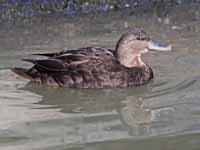



Duck, Eastern Spot-billed Anas zonorhyncha
Description: The eastern spot-billed duck has a black bill tipped with bright yellow. This yellow tip helps to identify the species and lead to its name. When visible, the blue speculum is striking. The speculum has a black leading edge and black plus white trailing edged. The legs and feet are orange. The plumage is mainly brown and grey, the head and neck are paler. There is a dark eye-line and bold white supercilium. The eastern spot-billed duck and the Indian spot-billed duck were formerly considered conspecific.
Range: Breeds in northeast Asia; winters in south Asia and the Philippines.
Habitat: Freshwater wetlands as well as coastal brackish wetlands. The wetlands are preferably with vegetation cover.
Diet: Mainly plants; also aquatic insects, mollusks, snails.
Conservation status: Least Concern.
Image by: 1, 2)
Dick Daniels - Sylvan Heights 3) AlpsdakeRange: Breeds in northeast Asia; winters in south Asia and the Philippines.
Habitat: Freshwater wetlands as well as coastal brackish wetlands. The wetlands are preferably with vegetation cover.
Diet: Mainly plants; also aquatic insects, mollusks, snails.
Conservation status: Least Concern.
2) Note the blue speculum.



Duck,_Indian Spot-billed Anas poecilorhyncha
Description: The Indian spot-billed duck has a red patch at the base of its bill. The male's patch becomes brighter and bigger during breeding season. The spot is absent in subspecies A. p. haringtoni. The bill is black tipped with bright yellow. It has a pale green speculum bordered with black and white. The legs and feet are orange. The plumage is mainly black and grey with a scaly appearance. The head and neck are paler. There is a dark eye-line. The eastern spot-billed duck and the Indian spot-billed duck were formerly considered conspecific.
Range: Indian subcontinent, Myanmar, Laos
Habitat: Freshwater wetlands, preferably with vegetation cover.
Diet: Mainly plants; also aquatic insects, mollusks, snails.
Conservation status: Least Concern.
Image by: 1) Lip Kee 2, 3)
Dick Daniels - Sylvan Heights 4) DavidvrajuRange: Indian subcontinent, Myanmar, Laos
Habitat: Freshwater wetlands, preferably with vegetation cover.
Diet: Mainly plants; also aquatic insects, mollusks, snails.
Conservation status: Least Concern.
1, 2) These images show the white tertials that form a stripe on the side.



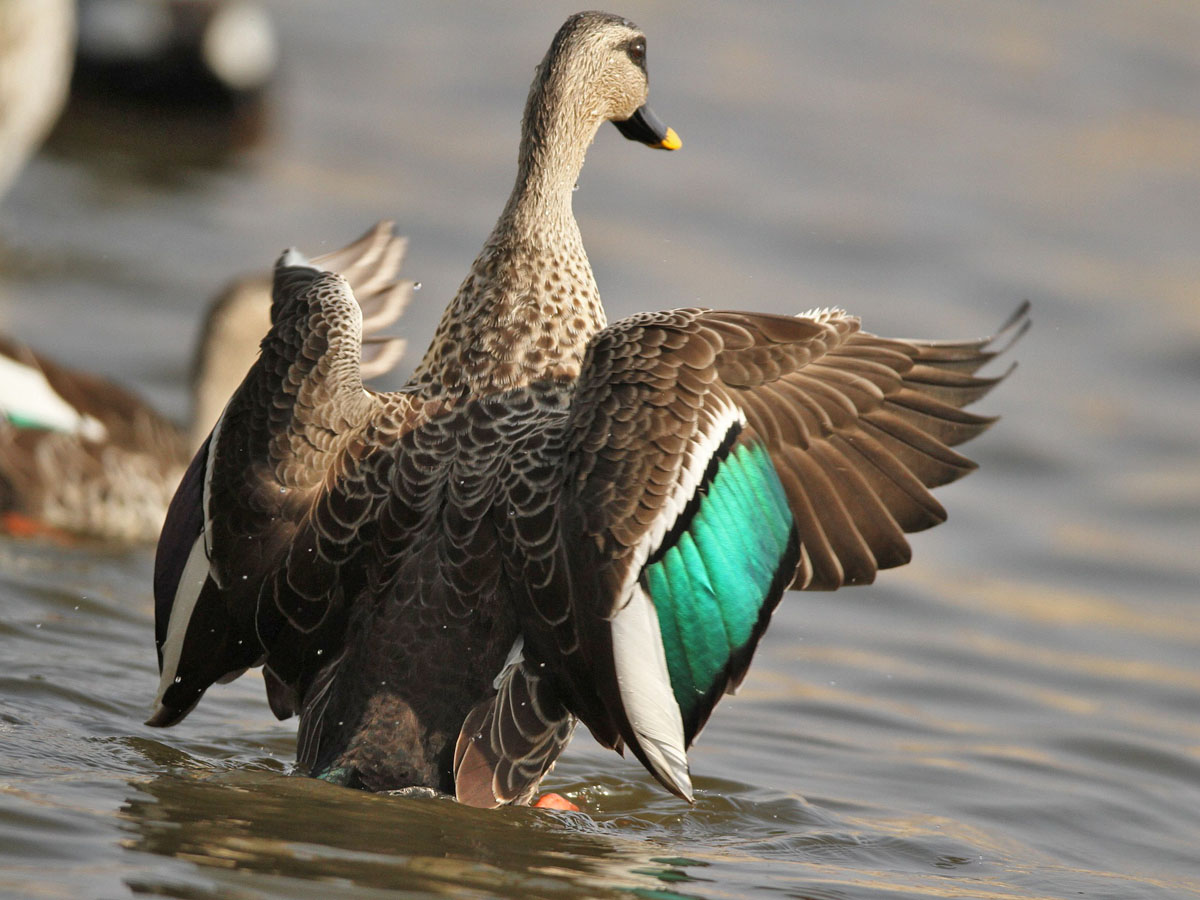
Duck,_Laysan Anas laysanensis
Description: The Laysan duck, also known as the Laysan teal, has mainly dark brown plumage. There is a dark purple-green speculum with a white trailing edge. It has a prominent white eye-ring plus orange legs and feet. The male has a dark green bill with black blotching, while the female has an orange bill with black blotching. It flies poorly, preferring to walk with its bill close to the ground to catch insects.
Range: Laysan island of Hawaii .
Habitat: Shallow water, mudflats.
Diet: Insects, algae, seeds, leaves.
Conservation status: The Layson duck is Critically Endangered due to a small population restricted to a small island. They are Vulnerable to introduced pests such as rabbits.
Image by:1) Caleb Slemmons 2) Jimmy_Breeden 3) Forest_and_Kim_StarrRange: Laysan island of Hawaii .
Habitat: Shallow water, mudflats.
Diet: Insects, algae, seeds, leaves.
Conservation status: The Layson duck is Critically Endangered due to a small population restricted to a small island. They are Vulnerable to introduced pests such as rabbits.



Duck,_Meller's Anas melleri
Description: The Meller's duck is similar to a large female mallard, However, it easy to tell them apart because the Meller's head is quite uniform in color - there is no dark eye-line and pale supercilium above. The speculum feathers (secondary wing feathers) are green and are bordered in white. The rest of the plumage is dark brown. Its pale grey bill is quite large; the legs and feet are orange.
Range: Eastern Madagascar .
Habitat: Fresh water such as: lakes, ponds, marshes, rice fields.
Diet: Insects, plants,seeds.
Conservation status: The Meller's duck is Endangered becaue of habitat loss. There are breeding programs and that will hopefully preserve the species, even though the Madagascar landscape is continuing to degrade.
Image by: 1, 2) Lt Shears - Louisville Zoo 3) Sarefo Range: Eastern Madagascar .
Habitat: Fresh water such as: lakes, ponds, marshes, rice fields.
Diet: Insects, plants,seeds.
Conservation status: The Meller's duck is Endangered becaue of habitat loss. There are breeding programs and that will hopefully preserve the species, even though the Madagascar landscape is continuing to degrade.

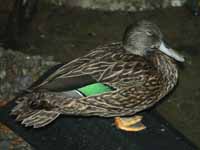
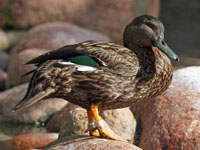
Duck,_Mottled Anas fulvigula
Descripthe tion: The mottled duck has a dark mottled body, lighter head and neck, orange legs and dark eyes. Both sexes have a shiny green-blue speculum (wing patch), which is not bordered with white. There is a black mark at gape (where bill joins face). The male's bill is bright yellow; the female's is deep to pale orange. The mottled ducks bright bill with its black spot at the gape, plus its pale face should distinguish it from similar species such as the Anericn black duck or mallard.
Range: Southeast North America .
Habitat: Freshwater wetlands such as ponds, marshes, flooded fields.
Diet: Mainly plants. Also aquatic insects and mollusks.
Conservation status: Least Concern.
Image by: 1) T Davis - Florida 2) Tom Friedel (BirdPhotos.com) - Florida 3, 4) Dick Daniels - Florida Range: Southeast North America .
Habitat: Freshwater wetlands such as ponds, marshes, flooded fields.
Diet: Mainly plants. Also aquatic insects and mollusks.
Conservation status: Least Concern.
1) Ducklings 2) Pair (male on left) 3) Female 4) Male




Duck,_Pacific Black also Grey Duck Anas superciliosa
Description: The Pacific black duck, also known in New Zealand as the grey duck, has a dark body, a paler head with a dark crown and facial stripes. The legs are dark yellow. In flight it shows a Iridescent green speculum which can appear blue. The underwing is pale. All plumages are similar. Hybrids between the Pacific black duck and mallards may cause the former's gene pool to tend more towards mallard characteristics.
Range: Australasia.
Habitat: Variety of wetlands as long as they have vegetation.
Diet: Mainly seeds and aquatic plants. Also small crustaceans, mollusks and aquatic insects.
Conservation status: Least Concern.
Image by: 1) Oystercatcher 2, 3) Dick - Sylvan Heights 4) birdsaspoetryRange: Australasia.
Habitat: Variety of wetlands as long as they have vegetation.
Diet: Mainly seeds and aquatic plants. Also small crustaceans, mollusks and aquatic insects.
Conservation status: Least Concern.


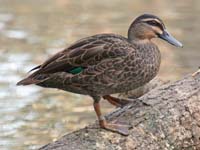
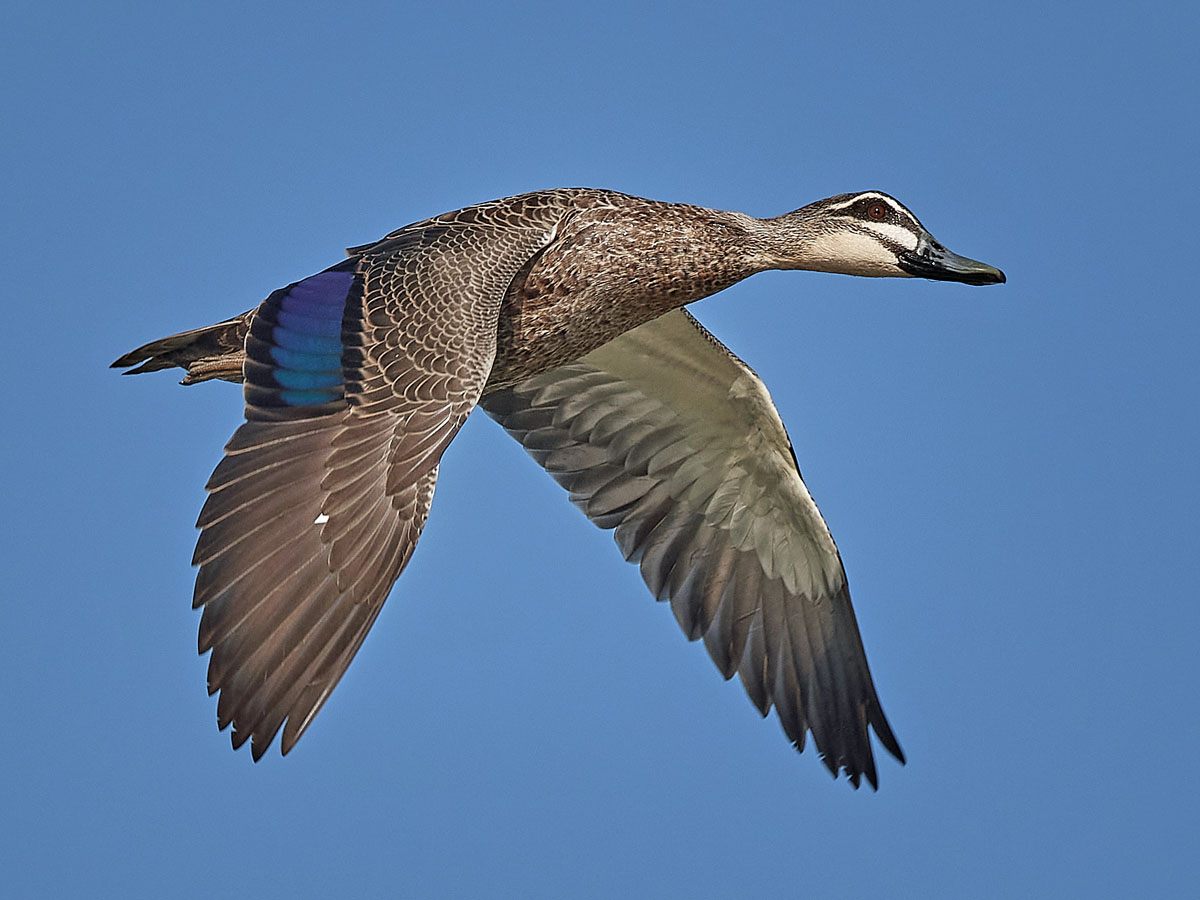
Duck,_Phiippine Anas luzonica
Description: The Philippine duck has a black crown, nape and eye stripe. The head and neck are cinnamon, the legs greyish brown, and the bill is blue grey. The rest of body is greyish brown with a bright blue / green speculum.
Range: Philippines, mostly on Luzon and Mindanao.
Habitat: A variety of wetlands. It prefers shallow freshwater marshes.
Diet: Shrimp, fish, insects, and vegetation.
Conservation status: The Philippine duck is Vulnerable because of overhunting and habitat loss.
Image by: 1) Mark_Harper - Luzon, Philippines 2, 3) Dick Daniels - Sylvan Heights 4) Ken_BillingtonRange: Philippines, mostly on Luzon and Mindanao.
Habitat: A variety of wetlands. It prefers shallow freshwater marshes.
Diet: Shrimp, fish, insects, and vegetation.
Conservation status: The Philippine duck is Vulnerable because of overhunting and habitat loss.




Duck,_Yellow-billed Anas undulata Found: Africa
Description: The yellow-billed duck has mottled grey plumage. The head and neck are dark grey while the bright yellow bill has a black median line. It has a greenish-blue speculum bordered with white.
Range: Africa (southern and eastern).
Habitat: Variety of wetlands as long as they have vegetation. Brackish coastal water is also acceptable.
Diet: Vegetation (aquatic and terrestrial). seeds, insects, mollusks.
Conservation status: Least Concern.
Image by: 1) Dick Daniels - Plettenberg Bay, South Africa 2, 3) Dick - Sylvan
Heights 4 Dick - Jacksonville Zoo, FloridaRange: Africa (southern and eastern).
Habitat: Variety of wetlands as long as they have vegetation. Brackish coastal water is also acceptable.
Diet: Vegetation (aquatic and terrestrial). seeds, insects, mollusks.
Conservation status: Least Concern.
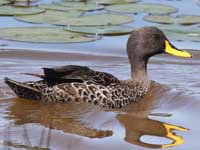



Koloa Anas wyvilliana
Description: The koloa is also known as the Hawaiian duck. Both male and female koloas resemble a female mallard. They have mottled dark brown plumage. The speculum varies from green to blue and is bordered with white. The male koloa has a darker head and neck than the female koloa. Koloas often inter-breed with mallards and it is to tell visually a duck is a pure koloa.
Range: Hawaiian Islands.
Habitat: Tall wetland grasses; streams. Usually found in pairs, not large groups.
Diet: Freshwater vegetation, mollusks, insects, and other aquatic invertebrates.
Conservation status: The koloa is Endangered because of habitat loss, non-native plants, habitat loss, and disease.
Image by: 1) USDA 2) Dick Daniels - Maui, Hawaii 3) Dick
Range: Hawaiian Islands.
Habitat: Tall wetland grasses; streams. Usually found in pairs, not large groups.
Diet: Freshwater vegetation, mollusks, insects, and other aquatic invertebrates.
Conservation status: The koloa is Endangered because of habitat loss, non-native plants, habitat loss, and disease.
1) Female in front, male in rear 2) Female left, male right 3) Female



Mallard Anas platyrhynchos
Description: The breeding male Mallard has a glossy green head with a white collar. Tbe breast is purple-tinged brown and they belly. Thre is a yellowish-orange bill tipped with black. Female and nonbreeding male are predominantly mottled with individual feathers varying from buff to dark brown, a coloration shared by most female dabbling ducks. Female and nonbreeding males havea dark eye-line and lighter supercilium. They have a blue speculum with white leading and trailing edges.
Range: The Americas, Europe, Asia, Africa, Australasia.
Habitat: Shallow freshwater and saltwater wetlands that have aquatic vegetation.
Diet: Seeds, plant greens, roots, tubers, snails, aquatic insects, crustaceans, worms, insects.
Similar to:
* American Black Duck. American black duck has darker plumage.
* Female Gadwall. Female gadwall has a squarer head than a female mallard. Mallard has more pronounced eye-line.
* Hawaiian Duck. Both male and female Hawaiian duck (koloa) resemble a female mallard, but have darker plumage.
*Mottled Duck. Mottled duck distinguished by black mark at its gape (where bill joins face).
Conservation status: Least Concern.
Image by: 1, 2, 3) Dick Daniels 4) Cristiano Crolle - Germignaga, Italy Range: The Americas, Europe, Asia, Africa, Australasia.
Habitat: Shallow freshwater and saltwater wetlands that have aquatic vegetation.
Diet: Seeds, plant greens, roots, tubers, snails, aquatic insects, crustaceans, worms, insects.
Similar to:
* American Black Duck. American black duck has darker plumage.
* Female Gadwall. Female gadwall has a squarer head than a female mallard. Mallard has more pronounced eye-line.
* Hawaiian Duck. Both male and female Hawaiian duck (koloa) resemble a female mallard, but have darker plumage.
*Mottled Duck. Mottled duck distinguished by black mark at its gape (where bill joins face).
Conservation status: Least Concern.
1) Chick 2, 3) female 4) male 5) pair


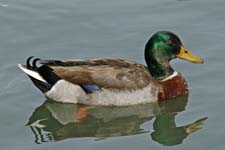

Pintail,_Eaton's Anas eatoni
Description: The Eaton's pintail has mottled brown upperarts and cinnamon buff underparts. Males and females have similar plumage,
Range: islands in southern Indian Ocean.
Habitat: Freshwater wetlands but also ocean bays in winter.
Diet: Seeds, grubs, worms, crustaceans.
Conservation status: The Eaton's pintail is Vulnerable because of feral cats.
Image by:
1) Hanuise 2) franek2Range: islands in southern Indian Ocean.
Habitat: Freshwater wetlands but also ocean bays in winter.
Diet: Seeds, grubs, worms, crustaceans.
Conservation status: The Eaton's pintail is Vulnerable because of feral cats.


Pintail,_Northern Anas acuta
Description: The northern pintail has a blue-grey bill plus grey legs and feet. The male has a long pointed tail, especially when breeding. He has grey, brown, and black patterning on its back and sides. The head is chocolate colored head with a white stripe going from the rear of the head to the white underparts. The speculum is metallic green (which can appear black) with a rufous leading edge and white trailing edge.The female has a plain brown head. The body has mottled brown plumage. Her speculum is dark brown with a narrow white leading edge and a broader white trailing edge.
Range: North America, Europe, Asia, Africa.
Habitat: Shallow freshwater wetlands with ample vegetation. During the winter, habitat may include brackish or saline waters.
Diet: Aquatic plants, seeds, Also snails, worms, crustaceans.
Conservation status: Least Concern.
Image by: 1, 3) Dick Daniels - Sylvan Heights 2) Imran_Shah - Pakistan 4) Andy_LiRange: North America, Europe, Asia, Africa.
Habitat: Shallow freshwater wetlands with ample vegetation. During the winter, habitat may include brackish or saline waters.
Diet: Aquatic plants, seeds, Also snails, worms, crustaceans.
Conservation status: Least Concern.
1, 2) Female 3, 4) Male


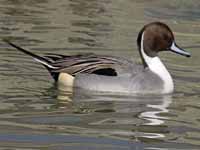
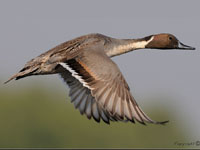
Pintail,_White-cheeked Anas bahamensis
Description: The white-cheeked pintail has brown upperparts. The head and nape are also brown with white cheeks and nape. The underparts are light brown with black spots. There is a bluish-grey bill with a definitive red spot.
Range: Galapagos Islands, South America; infrequently in Florida,
Habitat: Waters with some salinity, such as brackish lakes, estuaries and mangrove swamps.
Diet: Mainly aquatic plants; also aquatic insects and invertebrates.
Conservation status: Least Concern.
Image by: 1, 4) Dick Daniels - Sylvan Heights 2) Dick - the Galapagos Islands 3) Dick - Washington National ZooRange: Galapagos Islands, South America; infrequently in Florida,
Habitat: Waters with some salinity, such as brackish lakes, estuaries and mangrove swamps.
Diet: Mainly aquatic plants; also aquatic insects and invertebrates.
Conservation status: Least Concern.
4) White morph




Pintail,_Yellow-billed Anas georgica
The yellow-billed pintail has a brown head and neck plus a brownish tail. The upper wings are greyish brown and the secondaries are blackish-green. The yellow-billed pintail has a black speculum with a buff leading edge. The rest of the plumage is buffish brown with varying size black spots. Its identifying feature is the yellow bill with black tip and black stripe. The yellow-billed teal does have a similar bill, but that species has a larger spots on its breast.
Range: South America.
Habitat: Ranges from high elevation lakes and marshes to low elevation lakes and rivers open country. Also coastal.
Diet: Aquatic plants and occasionally land-based plants. Also snails, mollusks, worms, shrimp.
Conservation status: Least Concern.
Image by: 1) Dick Daniels - Sylvan Heights 4) Charlie Westerinen - Tierra Del Fuego 6) Nick Athanas - Argentina 7) Dick - ChileRange: South America.
Habitat: Ranges from high elevation lakes and marshes to low elevation lakes and rivers open country. Also coastal.
Diet: Aquatic plants and occasionally land-based plants. Also snails, mollusks, worms, shrimp.
Conservation status: Least Concern.


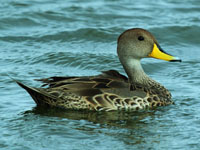
Description: The Australian wood duck, also khown as the maned duck, is grey with a dark brown head and mottled breast. The male has a black mane-like crest. The female has white stripes above and below the eye and also mottled flanks. Traditionally placed in the subfamily Anatinae (dabbling ducks), it might belong to the subfamily Tadorninae (shelducks). It is similar to the Spotted Whistling-Duck, but their heads are very different.
Range: Australia.
Habitat: Grasslands, wetland, and the sea coast. It prefers to forage on land.
Diet: Mainly grasses, grains, clover and other herbs; also insects.
Conservation status: Least Concern.
Image by: 1, 2, 3, 4)
Dick - Sylvan Heights Waterfowl Park Range: Australia.
Habitat: Grasslands, wetland, and the sea coast. It prefers to forage on land.
Diet: Mainly grasses, grains, clover and other herbs; also insects.
Conservation status: Least Concern.
1, 2) Female 3, 4) Male




Genus Hymenolaimus - 1 species
Nearest relatives of the blue duck are thought to be some South American dabbling ducks. It was previously thought to a member of the shelduck family.
Duck,_Blue Hymenolaimus malacorhynchos
Description: The blue duck has bluish-grey upperparts and belly. There are chestnut spots on its breast. It has a pinkish-white bill with a black tip. The sexes have similar appearance; the male is larger.
Range: New Zealand.
Habitat: Mountain streams and fast moving rivers.
Diet: Mainly aquatic insect larvae. Also berries, algae. Feeds by diving and dabbling.
Conservation status: Least Concern.
Image by: 1) Bernard Spragg 2) Karora 3) MartinRange: New Zealand.
Habitat: Mountain streams and fast moving rivers.
Diet: Mainly aquatic insect larvae. Also berries, algae. Feeds by diving and dabbling.
Conservation status: Least Concern.

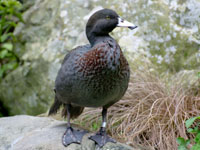

Genus Lophonetta - 1 species
Duck,_Crested Lophonetta specularioides
Description: The crested duck, also known as the South American crested duck, has dark brown upperparts with some light mottling and a dark greyish-brown crown that ends in a shaggy crest. It has a dark mask and a white speculum with a black leading edge. The underparts are mottled light brown. It is similar to the marbled duck, but their ranges do not overlap.
Range: South America.
Habitat: Lakes, marshes, and grassy areas from shallow coastal bays to high elevation lakes.
Diet: They can be mainly carnivorous or herbivorous depending on the environment. Eats grass, kelp, seeds, snails, clams, crustaceans.
Conservation status: Least Concern.
Image by: 1, 2) Claudio Timm - Argentine Lake, Argentina 3) Charlie Westerinen - Ushuaia Argentina. 4) Tony_Castro - PeruRange: South America.
Habitat: Lakes, marshes, and grassy areas from shallow coastal bays to high elevation lakes.
Diet: They can be mainly carnivorous or herbivorous depending on the environment. Eats grass, kelp, seeds, snails, clams, crustaceans.
Conservation status: Least Concern.



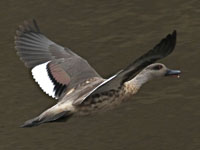
Genus Mareca
Duck,_Falcated Mareca falcata
Description: The term "falcated" refers to the long sickle-shaped feathers on the lower back of the falcated duck, which is also known as the falcated teal.The breeding male falcated duck has a grey body, dark green head, bronze crown, and white throat. It has a white spot at the base of its bill. The female has a mottled brown body and long grey bill. The nonbreeding male is similar to the female but darker on the back and head.
Range: Europe, Asia.
Habitat: Freshwater wetlands; also coasts in the winter.
Diet: Primarily herbivorous: leaves, seeds, grains, nuts. Also insect larvae, crustaceans, mollusks.
Conservation status: The falcated duck is near Threatened because of hunting in China.
Image by; 1, 2, 3, 4) Dick Daniels- Sylvan Heights Range: Europe, Asia.
Habitat: Freshwater wetlands; also coasts in the winter.
Diet: Primarily herbivorous: leaves, seeds, grains, nuts. Also insect larvae, crustaceans, mollusks.
Conservation status: The falcated duck is near Threatened because of hunting in China.
1) Female on top, bottom nonbreeding male 2, 3) Female 4.) Breedin male


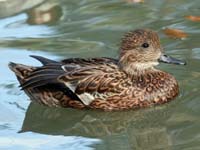
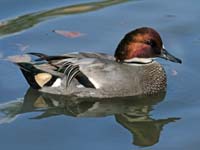
Gadwall Mareca strepera
Description: The breeding male gadwall has grey upperparts and underparts, light chestnut wings, and a white speculum. The female has a mottled brown body, dark orange-edged bill, white speculum, light belly. The nonbreeding male resembles the female but is greyer above and has less orange on the bill. The female gadwall is similar to the female mallard. Only the female mallard has a white or pale supercilium. Also, the mallard has a blue speculum while it is white for the gadwell.
Range: North America, Europe, Asia, Africa.
Habitat: Freshwater wetlands with aquatic vegetation.
Diet: Mainly aquatic vegetation. Also algae, invertebrates.
Conservation status: Least Concern.
Image by: 1) Jeff Whitlock - Texas 2, 3, ) Dick Daniels - Sylvan
Heights 4) Charlie Westerinen - UtahRange: North America, Europe, Asia, Africa.
Habitat: Freshwater wetlands with aquatic vegetation.
Diet: Mainly aquatic vegetation. Also algae, invertebrates.
Conservation status: Least Concern.
1, 2) Female 3, 4) Male




Wigeon, American Mareca americana
Description: The American wigeon has a white belly and grey legs. The breeding male has a green crescent from its eyes to nape. The striking off-white crown, which extends to its bill, leads to its alternate name "baldpate". The back and breast are pinkish brown. The pale silvery bill has a black tip. The nonbreeding male has vestigial green and white on its head. The female has a greyish-brown back, grey head, chestnut breast, white belly, and a black tipped grey bill. The American wigeon has a dark green speculum with a black leading edge. There is a large white patch above the speculum. The female American wigeon is similar to the Eurasian wigeon which has more uniform head color.
Range: North America, northwest South America.
Habitat: Freshwater wetlands, grasslands, agricultural fields.
Diet: Mainly vegetarian. Eats aquatic vegetation and also pasture grasses, winter wheat, clover.
Conservation status: Least Concern.
Image by: 1, 2, 3) Dick Daniels - Sylvan Heights 4) Alan D Wilson - near San Diego, CaliforniaRange: North America, northwest South America.
Habitat: Freshwater wetlands, grasslands, agricultural fields.
Diet: Mainly vegetarian. Eats aquatic vegetation and also pasture grasses, winter wheat, clover.
Conservation status: Least Concern.
1) Pair 2) Female 3 - 5) Male

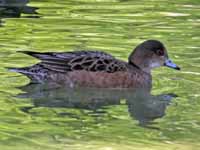
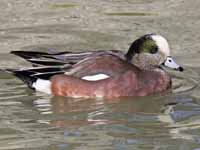
 Alan_D_Wilson_4650a.jpg)
Wigeon, Chilöe Mareca sibilatrix
Description: The Chiloe wigeon has a black back with white patterns, dark green head, white cheeks and forehead. The breast is black and white barred, and the sides are orange-brown sides. The pale grey bill has a white tip. The male and female are very similar - the male is larger and has whiter forehead.
Range: South America (southern part)
Habitat: Freshwater lakes, marshes, shallow lagoons and slow flowing rivers. Also coastal shorelines.
Diet: Mainly vegetarian: aquatic greens, seeds, grasses. Also worms, larvae.
Conservation status: Least Concern.
Image by: 1) Mehmet_Karatay 2, 3) Dick Daniels - Sylvan HeightsRange: South America (southern part)
Habitat: Freshwater lakes, marshes, shallow lagoons and slow flowing rivers. Also coastal shorelines.
Diet: Mainly vegetarian: aquatic greens, seeds, grasses. Also worms, larvae.
Conservation status: Least Concern.

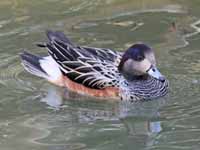

Wigeon, Eurasian Mareca penelope
Description: The Eurasian wigeon has a white belly, grey legs and a small black tipped light bill. The breeding male has a grey back and flanks, chestnut head and neck, off-white crown that extends to its bill, and a pinkish-grey breast. The female has mainly brown upperparts with a uniform brown head. The underparts are white with pink-buff flanks. The nonbreeding male resembles the female. The female can be a rufous morph with a redder head, and a grey morph with a more grey head. The female American wigeon is similar to the Eurasian wigeon which has more uniform head color. Video by Avibirds.com
Range: Europe, Asia, Africa. Rare in North America.
Habitat: Open wetlands, such as wet grassland or marshes.
Diet: Mainly vegetarian: aquatic plants, grasses; also some insects and invertebrates.
Conservation status: Least Concern.
Range: Europe, Asia, Africa. Rare in North America.
Habitat: Open wetlands, such as wet grassland or marshes.
Diet: Mainly vegetarian: aquatic plants, grasses; also some insects and invertebrates.
Conservation status: Least Concern.
1, 2) Female 3) Pair 4 )Male




Genus Pteronetta - 1 species
Duck,_ Hartlaub's Pteronetta hartlaubii
Description: The Hartlaub's Duck has chestnut plumage with a black head and upper neck. It has white above the base of the bill. There is a blue wing patch. The male has more white on the head than the female.
Range: Africa.
Habitat: Marshes, streams, pools; all located in forests.
Diet: Insects, spiders, crustaceans, mollusks. Also some vegetation.
Conservation status: Least Concern.
Image by: 1) Nik Borrow - Cameroon 2, 3) Dick Daniels - Sylvan HeightsRange: Africa.
Habitat: Marshes, streams, pools; all located in forests.
Diet: Insects, spiders, crustaceans, mollusks. Also some vegetation.
Conservation status: Least Concern.
1) Pair, female on left 2, 3) Male
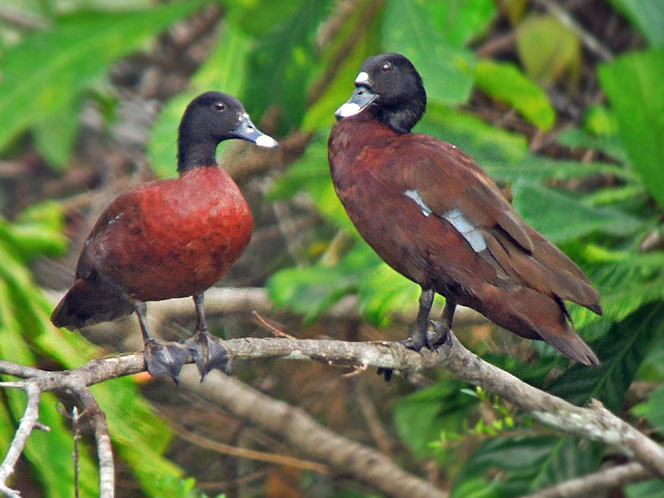


Genus Sarkidiornis
The two species of this genus do not have any close relatives (except each other).
Duck,_Comb Sarkidiornis sylvicola
Description: The comb duck has a white head speckled with dark spots, white underparts, and glossy blue-black upperparts. The male has a black knob on the bill. The male has dark flanks; the female has medium colored flanks.
Range: South America.
Habitat: Tropical wetlands.
Diet: Prefers seeds and grains. Also aquatic plants, invertebrates.
Conservation status: Least Concern.
Image by: BS Thurner Hof Sandy ColeRange: South America.
Habitat: Tropical wetlands.
Diet: Prefers seeds and grains. Also aquatic plants, invertebrates.
Conservation status: Least Concern.

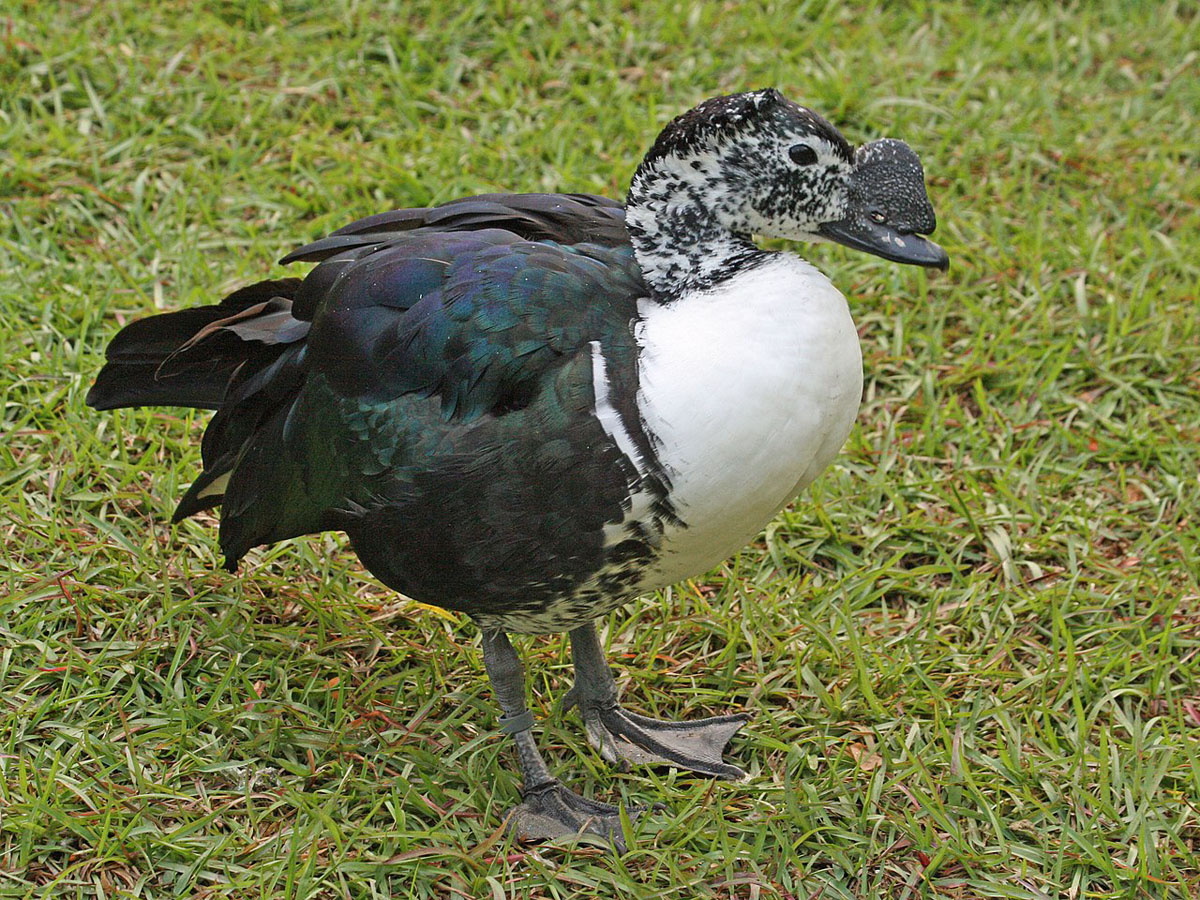
Duck,_Knob-billed Sarkidiornis melanotos
Description: The Knob-billed Duck has a white head speckled with dark spots, white underparts, and glossy blue-black upperparts. The male has a black knob on the bill. The flanks are light colored.
Range: Asia (Indian Subcontinent to Laos and extreme southern China), Africa
Habitat: Freshwater wetlands, usually with some trees around.
Diet: Prefers seeds and grains. Also aquatic plants, invertebrates.
Conservation status: Least Concern.
Image by: 1) JM Garg - India 2, 3) Charles J Sharp - India, Ethiopia 4) Bernard Dupont - South AfricaRange: Asia (Indian Subcontinent to Laos and extreme southern China), Africa
Habitat: Freshwater wetlands, usually with some trees around.
Diet: Prefers seeds and grains. Also aquatic plants, invertebrates.
Conservation status: Least Concern.
1, 2) Female 3. 4) Male

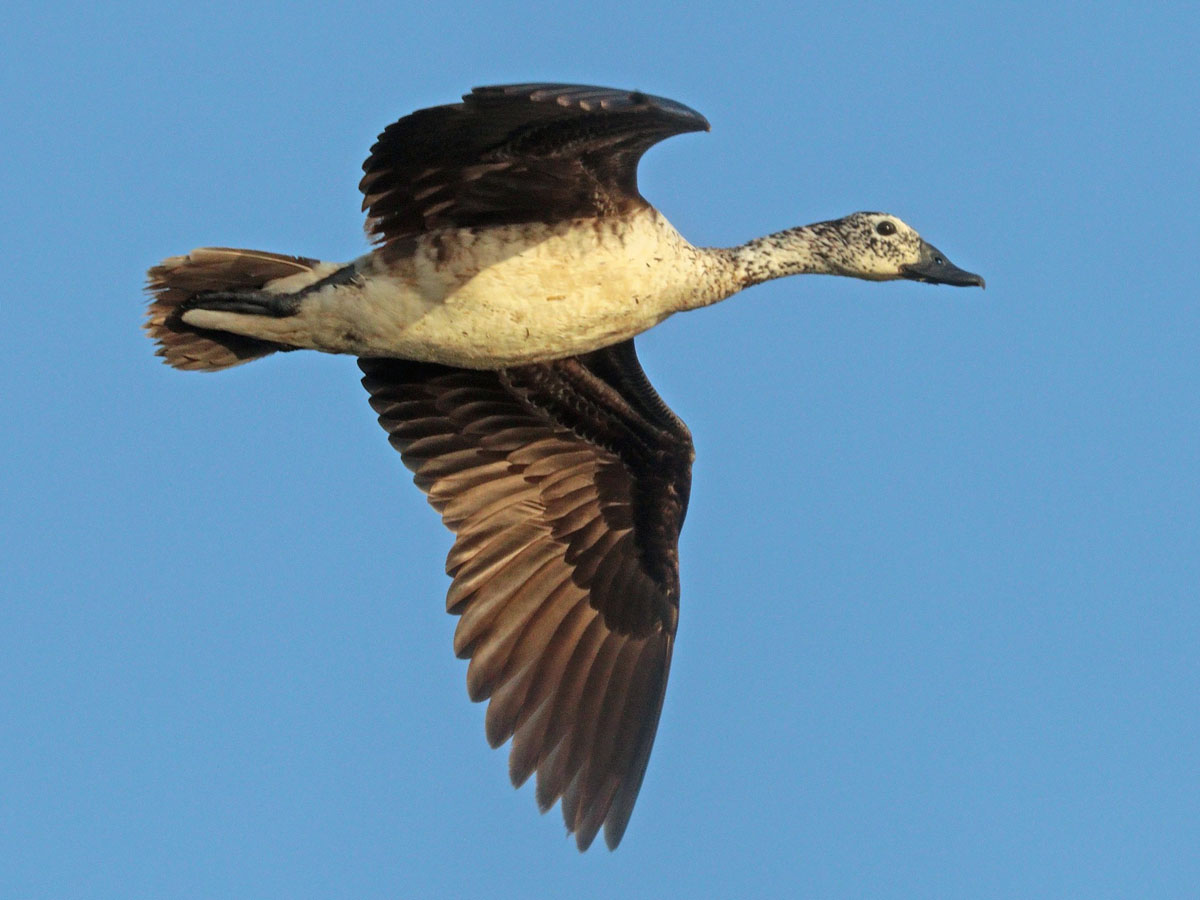


Genus Sibirionetta - 1 species
The Baikal was formerly placed in genus Anas.
Teal,_Baikal Sibirionetta formosa
Description: The male Baikal teal has dark brown crown with a white supercilium passing above the eye and ending at the nape. The yellow face has a striking black swirl and there is also yellow on the front of neck. The breast is light brown with dark spots. The brown back has long scapulars and the sides are grey. It has a dark green speculum with red leading edge and white trailing edge. The female Baikal teal has a white spot at the base of its bill and the faint hint of a white supercilium. It has a brown back with short scapulars.
Range: Asia.
Habitat: Nests in freshwater wetlands with trees close by, also in Arctic tundra. Nonbreeding it may also be found in brackish water.
Diet: Aquatic plants and invertebrates. Also rice.
Conservation status: Least Concern.
Image by: 1) Ken 2) Tokumi 3) Sarefo 4) Dick Daniels - Sylvan HeightsRange: Asia.
Habitat: Nests in freshwater wetlands with trees close by, also in Arctic tundra. Nonbreeding it may also be found in brackish water.
Diet: Aquatic plants and invertebrates. Also rice.
Conservation status: Least Concern.
1) Juvenile male 2) Female 3, 4) Male




Genus Spatula
The shovelers have very long bills. Their wide-flat bill is equipped with small, comb-like structures on the edge of the bill that act like sieves, allowing the birds to skim crustaceans and plankton from the water's surface. The genus contains many species that are termed teals, but they are not included in this article. See teals.
Garganey Spatula querquedula
Description: The male garganey has a brown head and breast, a reddish-brown face, and a broad white crescent over the eye. The rest of the plumage is grey as well as the bill and legs. The brown female garganey has a dark eye-line with a pale supercilium above. There is a white loral spot. The speculum is green (male) or greenish-brown (female). The female can be told from the female blue-winged by that specie's white eye-ring. Its white loral spot helps to differentiate the female garganey from the female green-winged teal.
Range: Europe, Asia, Africa, Australasia.
Habitat: Wetlands with vegetation showing above the surface.
Diet: Aquatic plants, seeds, fish, mollusks, crustaceans, This species feeds mainly by skimming rather than upending.
Conservation status: Least Concern.
Image by: 1) Sergey Pisarevskiy - Siberia, Russia 2) Frankie Chu 3 Dick Daniels - Sylvan Heights 4) Sandy Cole - Sylvan HeightsRange: Europe, Asia, Africa, Australasia.
Habitat: Wetlands with vegetation showing above the surface.
Diet: Aquatic plants, seeds, fish, mollusks, crustaceans, This species feeds mainly by skimming rather than upending.
Conservation status: Least Concern.
1, 2) Female. 3, 4) Male
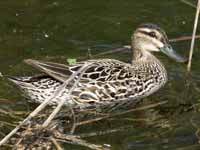

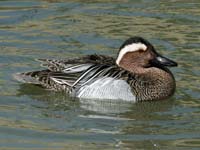

Shoveler,_Australasian Spatula rhynchotis
Description: The breeding male Australasian shoveler has a blue grey head, vertical white stripe near base of bill, chestnut underparts, and yellow eyes. Nonbreeding males are duller. The female has mottled brown upperparts and underparts. She has dark brown eyes.
Range: Australia, New Zealand.
Habitat: Freshwater wetlands during breeding seasons. Other times habitat expanded to incude brackish and saline waters.
Diet: Seeds, aquatic plants, crustaceans, mollusks.
Conservation status: Least Concern.
Image by: 1) Laurie_Boyle 2, 3, 4) Dick Daniels - Sylvan HeightsRange: Australia, New Zealand.
Habitat: Freshwater wetlands during breeding seasons. Other times habitat expanded to incude brackish and saline waters.
Diet: Seeds, aquatic plants, crustaceans, mollusks.
Conservation status: Least Concern.
1) Pair 2, 3) Female 4, 5) Male




Shoveler,_Cape Spatula smithii
Description: The cape shoveler has mottled grey brown plumage. It has a dark bill and orange legs. The male has yellow eyes, the female brown.
Range: Africa, mainly in South Africa.
Habitat: Open wetlands, such as wet grassland or marshes with some emergent vegetation (plants that extend above the water surface). Mud-bottomed marshes are preferred if rich in invertebrate life.
Diet: Mainly plants, also mollusks and aquatic insects during breeding season.
Conservation status: Least Concern.
Image by: 1, 2, 3, 4) Derek_Keats Range: Africa, mainly in South Africa.
Habitat: Open wetlands, such as wet grassland or marshes with some emergent vegetation (plants that extend above the water surface). Mud-bottomed marshes are preferred if rich in invertebrate life.
Diet: Mainly plants, also mollusks and aquatic insects during breeding season.
Conservation status: Least Concern.
1) Female left, male right 2) Female 3, 4) Male
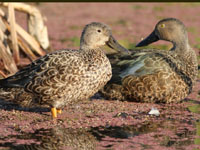

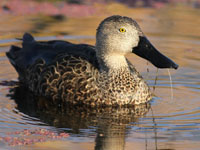

Shoveler,_Northern Spatula clypeata
Description: The breeding male northern shoveler has a greenish black head, white breast, and a chestnut belly and flanks. The bill is black, the eyes are yellow. The female has mottled brown plumage, an orange bill tinged with grey, and brown eyes. Nonbreeding males are duller than breeding males
Range: North America, Europe, Asia, Australia (rare).
Habitat: Open wetlands, such as wet grassland or marshes with some emergent vegetation (plants that extend above the water surface). Mud-bottomed marshes are preferred if rich in invertebrate life.
Diet: Seeds, plants, plankton, invertebrates, and aquatic insects.
Conservation status: Least Concern.
Image by: 1, 2, 3, 4,)
Dick - Sylvan Heights Waterfowl Park Range: North America, Europe, Asia, Australia (rare).
Habitat: Open wetlands, such as wet grassland or marshes with some emergent vegetation (plants that extend above the water surface). Mud-bottomed marshes are preferred if rich in invertebrate life.
Diet: Seeds, plants, plankton, invertebrates, and aquatic insects.
Conservation status: Least Concern.
1) Pair 2) Female 3. 4) Breeding male




Shoveler,_Red Spatula platalea
Description: The red shoveler has mainly cinnamon colored plumage with dark spots. It has a light grey head and a huge black bill. The female has brown eyes and the male has pale yellow eyes.
Range: South America .
Habitat: Shallow lakes, marshes, brackish coastal estuaries.
Diet: Aquatic plants, plankton, invertebrates, and aquatic insects.
Conservation status: Least Concern.
Image by: 1, 3) Nick Athanas - Argentina 2) Dick Daniels - Sylvan Heights Range: South America .
Habitat: Shallow lakes, marshes, brackish coastal estuaries.
Diet: Aquatic plants, plankton, invertebrates, and aquatic insects.
Conservation status: Least Concern.
1) Female 2, 3) Male



Genus Speculanas - 1 species
Duck,_Bronze-winged Speculanas specularis
Description: The bronze-winged duck, also known as the spectacled duck, has a bronze speculum. The head is dark brown with white spectacle, and a white partial collar. It has mainly blackish-brown upperparts, and mottled tan / dark brown underparts. The male has a darker head than the female.
Range: South America.
Habitat: Forested rivers and fast-flowing streams; also pools and ponds near forests
Diet: Acquatic vegetation, snails, invertebrates.
Conservation status: The bronze-winged duck is Near Threatened because although widespread, there may be less than 10,000 of this species.
Image by: 1, 2, 3) Dick Daniels - Sylvan Heights 3) Dick - Sylvan HeightsRange: South America.
Habitat: Forested rivers and fast-flowing streams; also pools and ponds near forests
Diet: Acquatic vegetation, snails, invertebrates.
Conservation status: The bronze-winged duck is Near Threatened because although widespread, there may be less than 10,000 of this species.
1) Female front, male rear 2) Female 3) Male
